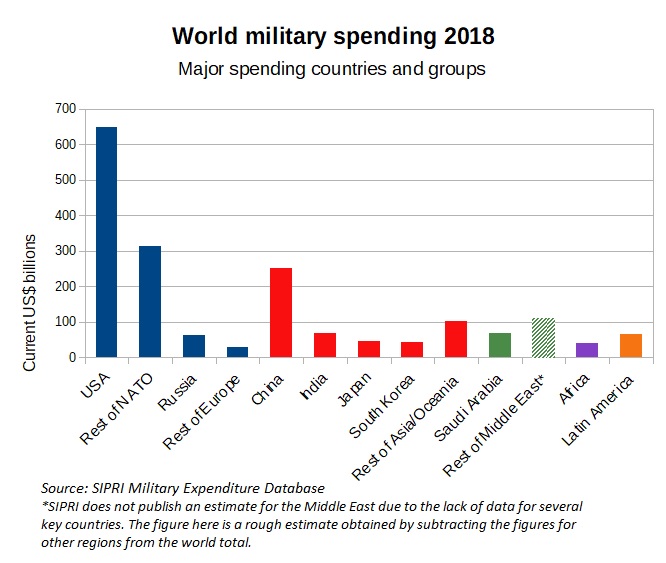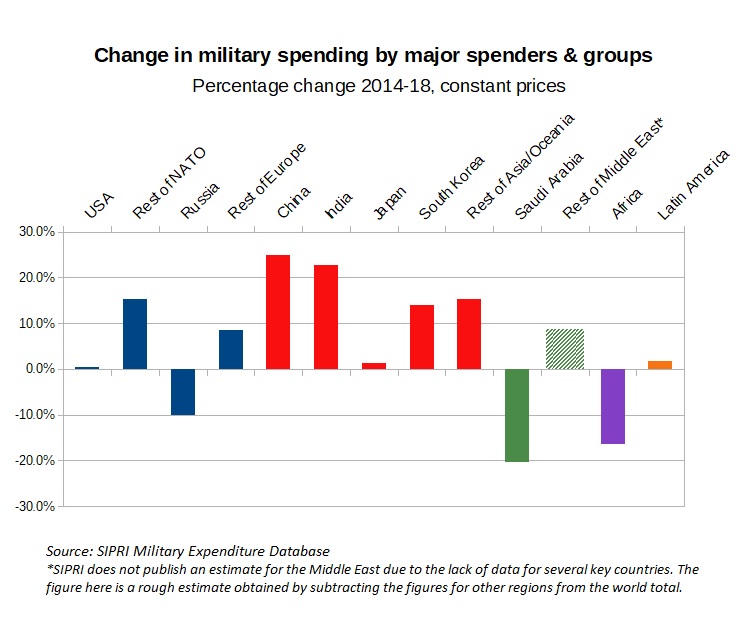World military spending is going up, according to data released this week by the Stockholm International Peace Research Institute (SIPRI), the most authoritative and comprehensive international source on military expenditure.1 According to SIPRI, the world total increased by 2.6% in real, inflation-adjusted terms, reaching an estimated $1,822 billion. The figure is almost certainly an underestimate, given that some countries are completely excluded due to a lack of data (notably Qatar, Syria, and North Korea). A number of other countries, typically those with large natural resource revenues such as the Gulf states, often exclude spending on arms imports from the limited information they publish, funding such purchases directly from oil revenues without including them in the official budget.
SIPRI discuss the latest figures in their fact sheet. They note that, in real terms, world military spending is 76% higher than its modern low point in 1998, after the end of the Cold War briefly sparked hopes of a ‘peace dividend’. But more than this, the 2018 total is 19% higher in real terms than the level recorded in 1988, the earliest year where a world total is recorded in the SIPRI database. This period was around the highest level during the Cold War, which means that the current total is almost certainly the highest level of world military spending since the end of World War 2.

Austerity in the west briefly led to small falls in global military spending between 2010 and 2014, but since then the total has been climbing again – despite a crash in oil prices that year that has seen substantial falls in many oil-dependant countries: major powers like Saudi Arabia and Russia, as well as smaller countries such as Angola, South Sudan, and Venezuela – countries that had previously been splurging their oil wealth on the military while prices were high. (The 20% cut in spending in Saudi Arabia has not stopped them pursuing their brutal war in Yemen of course).
But oil fluctuations aside, the world is busily pursuing a renewed arms race, as conflicts rage in the Middle East, tensions soar in eastern Europe, and a new “great power” rivalry game is played out in the Asia Pacific region.
Europe is re-arming against a perceived Russian threat. Russia, in turn, has been re-arming in the face of overwhelming military dominance from a NATO that had expanded all the way to its borders. China has been steadily building its military power as its economy has grown, against the perceived threat of US military dominance, while the US seeks to maintain its advantage. China’s neighbours, in particular India, Japan, and many of the countries bordering the disputed South China Sea, are arming themselves against the perceived Chinese threat. And countries on all sides proclaim the threat of terrorism as a reason for ever more military spending, in spite of the disastrous results of attempting to tackle terrorism by military means over the past nearly 20 years.

The sums spent worldwide on tackling these various “threats”, real of perceived, by building up the means of war (and thereby feeding the sense of threat on the part of neighbours and rivals in a self-perpetuating cycle), dwarves the sums spent on the most pressing threats to human and international security. Total Overseas Development Assistance (ODA) by the world’s richest countries (the OECD members) amounted to $145 billion in 2017, the most recent year available, just 8%, or less than a twelfth, of the latest military expenditure total. According to the most recent data from Climate Policy Initiative, average annual world spending, by both public and private sectors, over 2015-2016 was $463 billion – just over one quarter of world military spending.
Is this the right balance of priorities? We spend four times as much on fighting and preparing to fight each other as on fighting the climate catastrophe that could destroy us all, and 12 times as much as on tackling global poverty.
1Declaration of interest: the author was responsible for producing this data from 2009 to 2016
